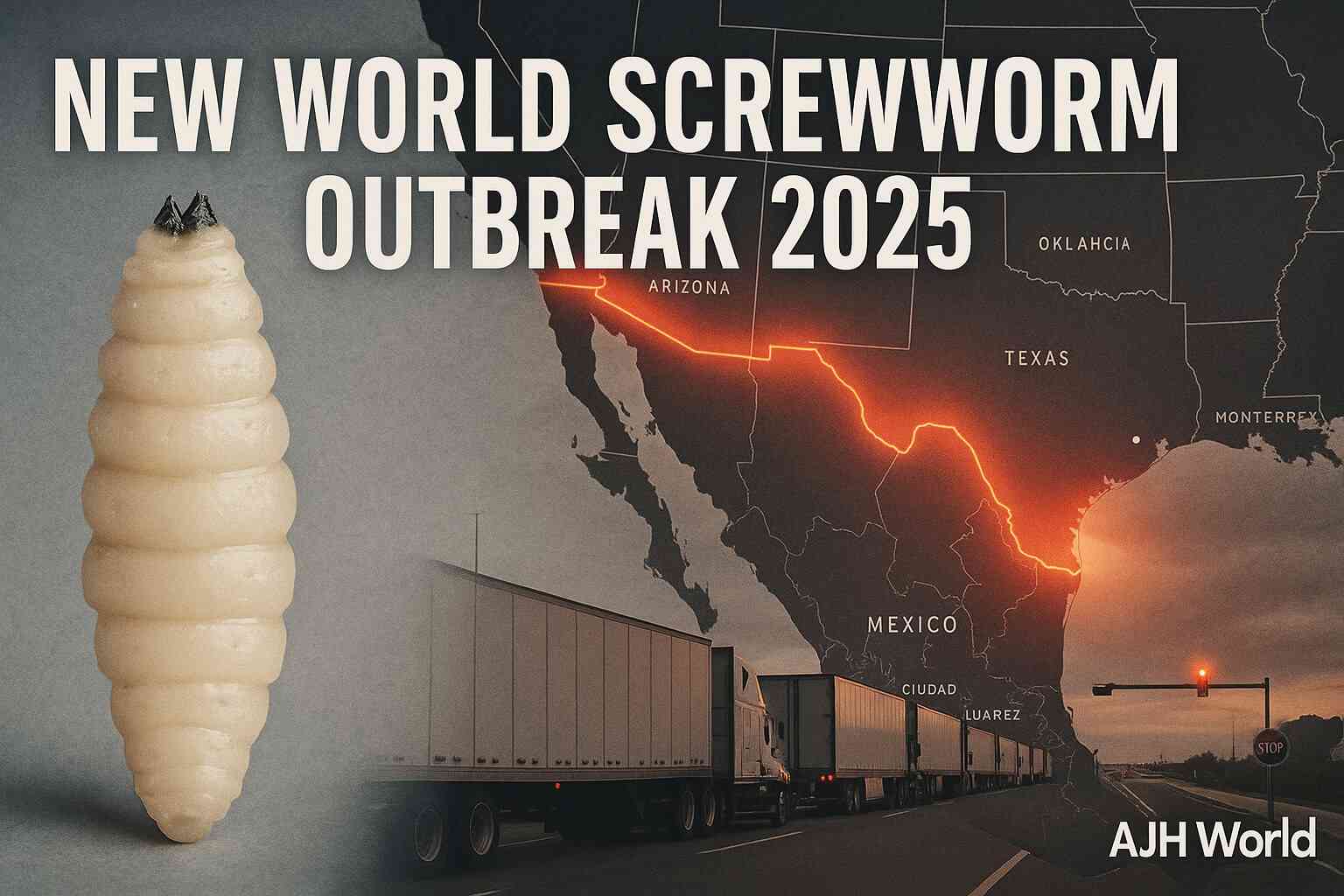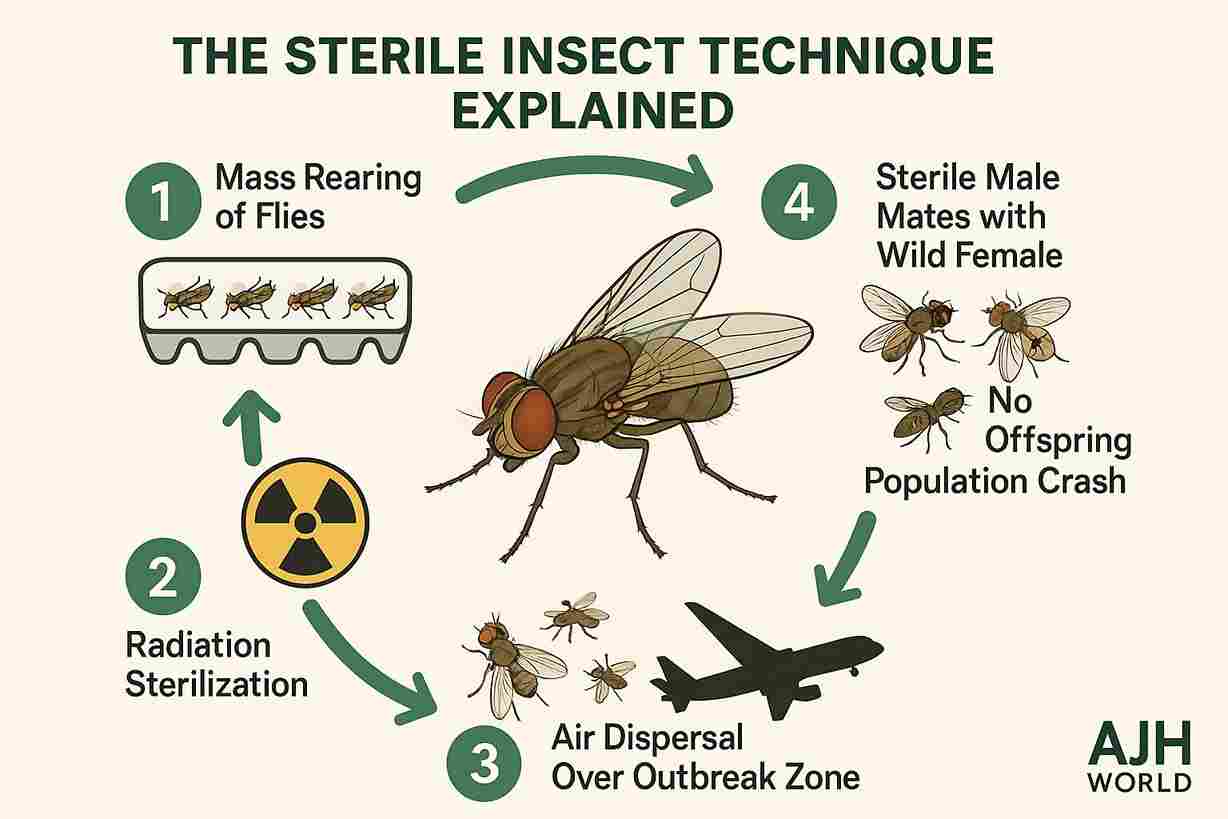A flesh-eating parasite is back. Understand the 2025 New World Screwworm outbreak, the US sterile fly response, Mexico’s criticism, and the impact on your wallet.
A long-eradicated, flesh-eating parasite is making a terrifying comeback, threatening North America’s livestock, economy, and public health. Here’s the urgent breakdown of the science, the stakes, and the high-level diplomatic standoff.
What if a horror movie creature came to life? Imagine a parasitic fly whose larvae, known as screwworms, feed on the living flesh of warm-blooded animals, including livestock, pets, and even humans. For decades, this was a threat confined to history books in the United States. But that’s changing.
The New World Screwworm Outbreak 2025 is no longer a distant threat—it’s a burgeoning crisis at the U.S.-Mexico border, triggering a multi-million dollar biosecurity response and igniting a sharp diplomatic conflict. As the U.S. deploys swarms of sterile flies in a high-tech battle against the pest, Mexico is criticizing a “drastic and damaging” border closure on key livestock trade routes.
In this essential guide, you’ll understand the full scope of this emergency. We’ll break down the gruesome nature of the screwworm, explain the brilliant science of the Sterile Insect Technique (SIT), analyse the economic shock waves heading your way, and explore the escalating political fallout. Stay informed on an issue that directly impacts food prices, international trade, and animal welfare across the continent.

1. What is the New World Screwworm? A Threat Reawakened
Let’s start with the basics.
The New World Screwworm (Cochliomyia hominivorax, which literally means “man-eater”) is the larva of a parasitic fly. Unlike other maggots that feed on dead tissue, this parasite is terrifyingly unique: it infests and consumes the living flesh of warm-blooded animals.
A female screwworm fly lays hundreds of eggs in an open wound, even one as small as a tick bite. When the eggs hatch, the larvae burrow into the healthy tissue, feeding and growing larger. This creates a larger wound, which in turn attracts more screwworm flies, leading to a gruesome, expanding infestation that is often fatal if left untreated.
The United States successfully eradicated the screwworm back in 1966 through a massive, ingenious campaign. For over 50 years, the pest was kept south of the Darien Gap in Panama, thanks to a permanent biological barrier. But the New World Screwworm Outbreak 2025 shows that this barrier may no longer be enough.
2. Timeline of the 2025 Screwworm Outbreak: How Did We Get Here?
This crisis didn’t happen overnight. It was a slow-moving storm that has now broken over the U.S.-Mexico border.
- Late 2024: Sporadic but alarming cases of screwworm are reported in cattle herds in southern Mexican states, farther north than seen in decades. Authorities believe unusually warm and wet weather patterns may have allowed the fly to breach traditional containment zones.
- January 2025: The outbreak intensifies, with reports from multiple central Mexican states. Mexico’s animal health agency, SENASICA, declares a regional state of emergency.
- March 2025: Cases are confirmed in the northern Mexican states of Chihuahua and Sonora, which share a major border and significant livestock trade with Texas, New Mexico, and Arizona. The alarm bells in Washington D.C. start ringing loudly.
- April 2025: In response to the imminent threat, the U.S. Department of Agriculture (USDA) announces a partial closure of the border to live cattle imports from affected regions and initiates its historic counter-measure: the sterile fly program.
3. Sterile Insect Technique (SIT): America’s Billion-Fly Counter-Attack
So, how do you fight a plague of flies? You fight them with more flies.
It sounds counter intuitive, but the Sterile Insect Technique (SIT) is a form of biological pest control that is both brilliant and environmentally friendly. According to the USDA’s Animal and Plant Health Inspection Service (APHIS), it’s one of the greatest entomological success stories in history.
What does this mean for the current crisis? The U.S. is ramping up production at its bi-national screwworm-rearing facility in Panama, which can produce over 100 million sterile flies per week. These flies are then air-dropped from low-flying planes over the affected border regions.
How Are Sterile Flies Made?
- Mass Rearing: Millions upon millions of screwworm flies are raised in a controlled, factory-like laboratory.
- Sterilization: Just before they become adults, the flies are exposed to a precise dose of ionizing radiation. This makes them sterile without otherwise harming their ability to fly, mate, or compete with wild flies.
- Dispersal: The sterilized flies are packaged and strategically released into the wild.
Why Is This Method So Effective?
Here’s the kicker: when the vast number of sterile male flies are released, they overwhelmingly outnumber the wild, fertile males.
The wild female flies, which only mate once in their lifetime, are far more likely to mate with a sterile male. This mating produces no offspring. With each generation, the wild population plummets until it is completely wiped out. No chemical pesticides are needed, and no other species are harmed.

4. Mexico’s Position: The Economic Fallout of Border Closures
While the U.S. views its actions as a necessary defense of its $100+ billion livestock industry, Mexico has a different perspective.
The closure of key border crossings to live cattle has been called “premature and punitive” by Mexican economic officials. Their argument is twofold:
- Economic Harm: Mexico is a massive exporter of feeder cattle to the U.S. The border closure severs a vital economic lifeline for Mexican ranchers, with a Bloomberg report estimating the trade to be worth several billion dollars annually.
- Cooperative Strain: Mexican officials claim they are actively fighting the outbreak and that a full-scale border closure undermines cooperative bi-national health efforts. They advocate for more targeted restrictions and enhanced screening, rather than a blanket ban.
This disagreement has created significant diplomatic friction, turning a shared biological crisis into a political dispute. The New World Screwworm Outbreak 2025 is now testing the limits of North American trade and partnership.
5. Economic Shockwaves: How the Screwworm Outbreak Could Affect Your Wallet
This isn’t just a problem for ranchers. A full-blown screwworm infestation in the U.S. would have a domino effect that reaches your dinner table.
H3: Rising Meat & Dairy Prices
If the outbreak crosses the border and takes hold, it could devastate U.S. cattle, swine, and sheep populations.
- Supply Shortage: Widespread animal loss would lead to a significant shortage of beef, pork, and dairy.
- Price Hikes: Basic economics dictates that when supply plummets and demand remains high, prices soar. Consumers in the U.S., Canada, and even Germany (which imports U.S. agricultural products) could see noticeable price increases at the grocery store.
H3: The Strain on American Ranchers
For American farmers and ranchers, the stakes are existential. A single infected animal can threaten an entire herd. The costs of veterinary care, round-the-clock monitoring, and potential culling of animals would be financially crippling, potentially bankrupting smaller family farms. This is why the U.S. government’s response has been so swift and severe.
Curious about how global events disrupt local markets? Read our analysis on Microsoft Outlook Outage 2025: The Day Email Died and What Caused the Global Crash on AJH World.
6. Are Humans and Pets at Risk? The Unsettling Truth
The short answer is yes, though it is rare.
The hominivorax name (“man-eater”) is a clue. While the flies overwhelmingly prefer livestock, they are opportunistic. Human cases, known as myiasis, typically occur in neglected open wounds, sores, or mucous membranes, often in vulnerable individuals like the elderly or infants.
Pets like dogs and cats are also susceptible. Any pet with an unhealed cut or wound in an outbreak area is at risk and should be monitored closely by its owners. Pet owners in border states are being advised by veterinarians to be hyper-vigilant.
7. What’s Next? The Future of Eradication and International Cooperation
The outcome of the New World Screwworm Outbreak 2025 hinges on two key factors:
- Effectiveness of the Sterile Fly Program: Will the air-dropped sterile flies be enough to create a biological barrier and crush the northward-advancing fly population?
- Diplomacy: Can the U.S. and Mexico resolve their dispute and forge a truly unified front against this common enemy?
Experts suggest that a successful campaign requires both. A permanent solution involves pushing the screwworm back to the Darien Gap in Panama and reinforcing the containment efforts there. This can only be achieved with full international cooperation. Technology may also play a role, with new developments in drone dispersal and genetic pest control on the horizon.
For a deeper dive into modern solutions, see our article: [The Role of AI in Disease Prediction on AJH World].
Frequently Asked Questions (FAQs) – New World Screwworm Outbreak 2025
It is the maggot (larva) of a parasitic fly that feeds exclusively on the living flesh of warm-blooded animals. Unlike regular maggots that eat dead tissue, these cause severe and often fatal injuries by consuming healthy tissue.
Yes, pets are at risk. Open wounds on dogs, cats, or other warm-blooded pets can be targeted by female flies laying eggs. Pet owners near outbreak zones should treat wounds promptly and consult a vet.
Mexico cites economic losses from the livestock trade closure, arguing that enhanced screening and targeted restrictions would be better. They believe the unilateral U.S. action harms longstanding trade relations.
The U.S. releases sterile male flies raised in factories. When these mate with wild females, no viable eggs hatch, crashing the population without using pesticides.
Yes. Commercial meat is safe due to strict safety protocols. Infected animals are removed from the food supply. The risk is mainly to live animals, not processed meat sold in stores.
The New World Screwworm Outbreak 2025 is a stark reminder that eradicated diseases can return with a vengeance, especially in a world with changing climate patterns and interconnected economies. The crisis at the U.S.-Mexico border is a complex tapestry of biology, cutting-edge science, high-stakes economics, and tense international diplomacy.
The U.S. response with the Sterile Insect Technique represents a monumental effort to protect its agricultural backbone. However, the resulting friction with Mexico highlights the delicate balance required to manage a shared threat. For consumers in the U.S., Canada, and Germany, the outcome of this battle will likely be felt in the price of groceries. For now, all eyes are on the border, watching a war being fought by billions of flies, with the health of an entire continent’s ecosystem and economy hanging in the balance.
What do you think is the right approach? Should bio-security trump trade agreements? Share your thoughts in the comments below, and subscribe to AJH World for ongoing expert analysis of global events.
Md Jewel Hossain is a seasoned SEO, Tech, and Business Analyst at AJH World. He specializes in breaking down complex global issues—from technological disruptions to economic crises—into clear, actionable insights for marketers, entrepreneurs, and curious minds.



Leave a Comment